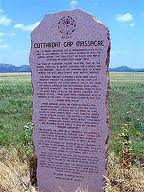 |
| courtesy: rebelcherokee.labdiva.com |
E. Taylor has prepared an interesting summary of some of the significant events that were depicted over the years on this calendar on her web site: rebelcherokee.labdiva.com/kiowacalndr.html .
In the Washita mountains just east of Cooperton and at the confluence of Rainy Mountain Creek and the Washita River, is a gentle valley. This is where the Kiowa people, led by Principle Chief Islandman A'date, set up their camp in 1833. The able warriors of the group split into groups. While some left to go north on a raiding party in the land of the Utes, other warrior parties went out hunting buffalo herds to bring back food supplies for the group. Women, the elderly and a few aging warriors remained in the camp with the children.
What happened in that camp one summer morning in 1833 has been told and re-told in many stories handed down by the Kiowa people. Historians in the 1960's recorded memories of some of these stories for the University of Oklahoma's Western History Collections. Guy Quoetone, born in 1886, was interviewed for this project and provided an extensive re-telling of the Kiowa memory of the event (interview T-28). An Osage war party slipped into the camp one morning and viciously attacked the people of Islandman A'date's camp. The Kiowa people, both surprised and outnumbered, could not defend their camp. While many escaped, it was estimated that at least 150 Kiowas were killed in the massacre. The Osage had struck without warning and left without losing a single Osage warrior. They took two young prisoners, the horses, and importantly, the sacred Tai-me medicine bundle used in the Kiowa Sun Dance.
But that was not all that the Osage warriors did. When the Kiowa warriors eventually returned they found the abandoned camp destroyed and 150 of their people dead. The bodies were strewn all around the camp. The bodies, however, had no heads. In gruesome horror, the returning warriors eventually found many of the heads had been stuffed into the camp's large brass cooking pots.
Guy Queotone recalled the story, "These Osages, they had long knives...And they stick some of them through them. But most of them they just hit on the neck and cut them off. They just cut their throat off. And they picked up the heads and throwed them in them brass buckets." He went on to describe something else the Osage had done, "They had (placed) 40 or 50 heads on the edge of a high mountain ridge...All laid side by side facing the village - the heads." At the time of a subsequent interview Queotone and three other old Kiowa men who knew the story took the historians to the actual valley site and showed them the ridge where the heads were lined up facing the village.
James Haumpy, also interviewed for the University of Oklahoma's Western History Collections (interview T-81), is quoted as saying, "Lot of Kiowas got killed out there. They cut their neck...neck off. Children, women's. Neck Cut-Off Mountain. That's what they call it."
The valley area where the Wichita River meets the Rainy Mountain Creek is known to us today as Cutthroat Gap. The place where the Cutthroat Gap Massacre took place in the "year the stars fell" and the "summer they cut off their heads."

3 comments:
Well that's pretty gruesome. You would think man, with all our smarts would come up with a better plan, to get along with his neighbors. It's not happened in the past, so I don't hold out much hope for the future either.
How awful! Sometimes I think it's assumed that because we have relatively few records from Indian culture that they were peaceful and quiet. Sadly, even a cursory investigation reveals that they are just like everyone else.
Gruesome indeed. I can almost see the heads lined up at the mountain ridge. I had never heard of this massacre before. I know that the Mesoamerican indians (Aztecs etc) knew their way around bloody massacres and decapitations...
Post a Comment